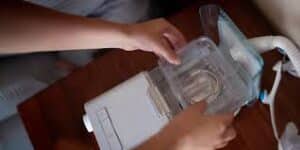
If you’ve ever woken up with a dry mouth or scratchy throat after using your CPAP machine, you’re not alone. Many people who start CPAP therapy quickly realize that while the treatment helps them breathe better, it can also make their airways feel parched. That’s where a CPAP humidifier comes in — a simple addition that can completely change your comfort level and make therapy easier to stick with.
Why CPAP Therapy Sometimes Feels Dry
CPAP therapy delivers a continuous stream of pressurized air to keep your airway open during sleep. But the air coming through your mask is often dry, especially if you live in a cool or air-conditioned space. When that dry air passes through your nose and throat for hours, it can pull moisture away from your tissues, leaving you with dryness, congestion, or even mild irritation.
Over time, that dryness can become one of the biggest reasons people struggle to keep up with their treatment. Fortunately, adding a humidifier to your CPAP setup is an easy fix that makes a big difference.
What a CPAP Humidifier Actually Does
A CPAP humidifier adds moisture to the air you breathe while you sleep. The machine pushes air through a small water chamber, where it picks up gentle humidity before reaching your mask. The result? Air that feels warmer, softer, and much easier on your airways.
Most modern CPAP systems now come with heated humidifiers, which warm the water slightly for added comfort. Some even allow you to adjust humidity and temperature separately, so you can fine-tune what feels best for your environment.
If you’ve ever woken up with “rainout” — droplets forming in your tube — heated tubing can help too. It keeps the temperature consistent and prevents that moisture from condensing inside the hose.
Why CPAP Humidifiers Improve Comfort and Compliance
Comfort isn’t just a luxury when it comes to CPAP — it’s a necessity. Studies show that people who use humidifiers with their therapy are more likely to continue using their machines regularly. Here’s why:
- Less Dryness and Irritation
Humidified air keeps your nasal passages and throat comfortable throughout the night, preventing soreness and cracked lips. - Better Sinus Health
Dry air can inflame nasal tissues, making it harder to breathe. Moisture keeps your sinuses open and reduces stuffiness. - Easier Breathing for Mouth Breathers
If you breathe through your mouth while sleeping, humidification prevents the painful dryness that often comes with full-face masks. - More Natural Sleep Quality
Breathing warm, moist air feels more like normal breathing — your body relaxes faster, and you wake up feeling fresher.
When therapy feels natural instead of mechanical, it becomes easier to use every night — and that’s when real results start showing.
Who Should Definitely Use a CPAP Humidifier
While every CPAP user can benefit from humidification, some people need it more than others. You’ll likely see the biggest difference if you:
- Live in a dry or cold environment
- Use high pressure settings on your machine
- Experience nasal congestion or allergies
- Sleep with your mouth open or use a full-face mask
- Wake up frequently with dry mouth or sore throat
If any of these sound familiar, you’ll probably notice immediate comfort once you start using a humidifier.
Tips for Using Your CPAP Humidifier the Right Way
To get the most out of your humidifier, small habits make a big difference:
- Use only distilled water. Tap water can leave mineral buildup in your chamber and damage the machine over time.
- Clean it daily. Empty leftover water each morning, rinse the chamber, and let it air dry to prevent bacteria.
- Adjust humidity slowly. If the air feels too wet or causes condensation, lower the level slightly until it feels just right.
- Try heated tubing. It keeps humidity stable and eliminates the annoyance of water collecting in your mask or hose.
Consistency with cleaning and settings ensures your humidifier continues working at its best — quietly improving your sleep night after night.
Troubleshooting Common CPAP Humidifier Issues
Even though humidifiers are simple devices, small issues can pop up now and then:
- Condensation or “rainout” in the hose: Lower the humidity setting, warm the room a bit, or use heated tubing.
- Dry air despite using a humidifier: Make sure the water chamber is properly seated and filled to the line.
- White buildup or odor: That’s mineral or mold growth — soak the chamber in a vinegar-water mix for 15 minutes, rinse, and let dry.
A few minutes of maintenance each week keeps your CPAP system fresh and performing optimally.
Final Thoughts: Comfort Is Key to CPAP Success
Humidifiers might seem like a small feature, but they play a huge role in how comfortable your CPAP therapy feels. When the air is properly humidified, breathing feels smoother, your sinuses stay healthy, and your throat stays free from that painful dryness that can discourage you from using your device.
Adding a CPAP humidifier isn’t just about comfort — it’s about making therapy sustainable. Once you experience how much better you sleep with moisture-controlled air, you’ll never want to go back to dry airflow again.
